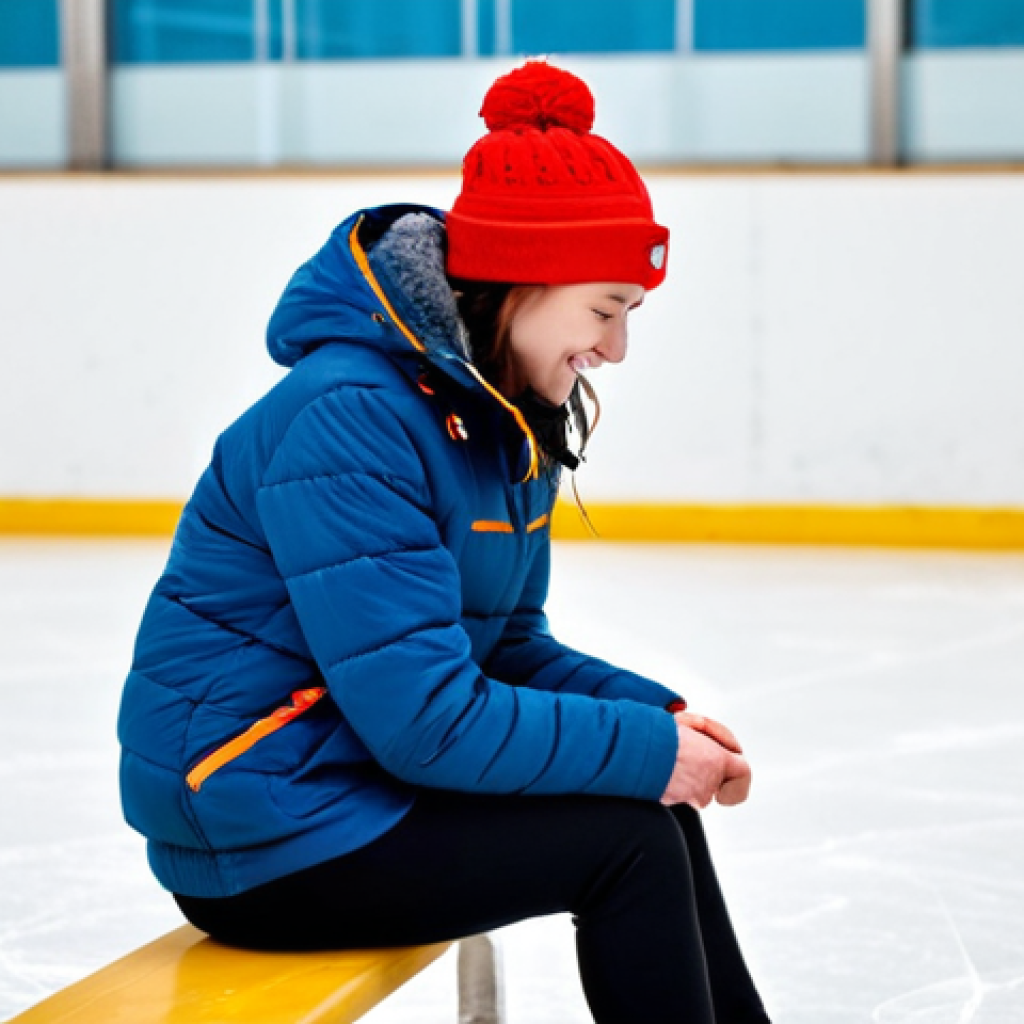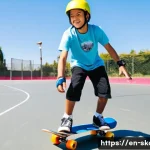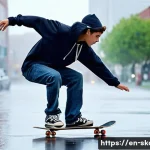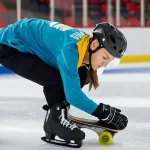Choosing the right equipment for ice skating can be a game-changer, whether you’re just starting out on the rink or aiming to perfect your triple axel.
From the skates themselves to protective gear and stylish apparel, each piece plays a vital role in your performance and safety. I remember when I first started skating; I underestimated the importance of proper fit and support, and it led to some wobbly ankles and near-misses!
Now, after years on the ice, I’ve learned what makes a difference. Plus, with advances in materials and design, the options available today are incredible.
There’s even buzz about smart skates with built-in performance tracking – talk about the future of skating! We’ll also delve into what to expect in the future, given current trends and emerging tech in the skating world.
Let’s explore what you need to know to gear up effectively. Let’s dive into all the details below!
Here’s a draft of your blog post:
Understanding the Anatomy of Ice Skates
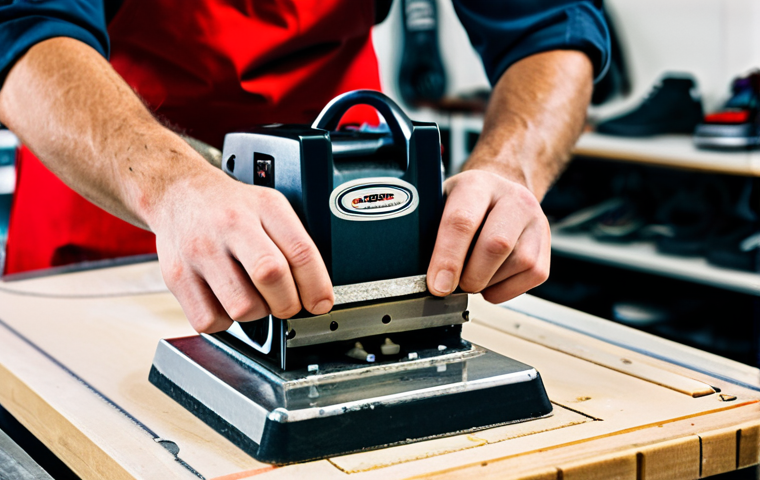
Ice skates aren’t just shoes with blades; they’re highly engineered pieces of equipment designed for performance, comfort, and safety. The key components include the boot, blade, and chassis (the part that connects the two). I remember once buying a cheap pair of skates online, and after just a few sessions, the boot started to separate from the chassis! That’s when I learned the hard way that quality counts.
Boot Material and Support
The boot’s material significantly impacts support and comfort. Leather boots offer excellent molding to the foot over time but require a break-in period. Synthetic materials, on the other hand, offer immediate comfort and are often lighter. The stiffness of the boot determines the level of ankle support. Beginners usually benefit from a stiffer boot, while advanced skaters might prefer more flexibility for complex maneuvers. Personally, I switched to a heat-moldable synthetic boot a few years ago, and the difference in responsiveness and comfort was night and day.
Blade Types and Their Uses
Blades come in various profiles and materials, each designed for specific skating disciplines. Figure skating blades have a toe pick for jumps and spins, while hockey blades are shorter and more curved for agility. Recreational skates often have a straighter blade for stability. The rocker (curvature of the blade) affects maneuverability; a more pronounced rocker allows for tighter turns. Blade materials also vary; carbon steel is common, but higher-end blades use stainless steel for better edge retention. I once tried switching from a standard recreational blade to a figure skating blade just for fun, and let’s just say my attempts at jumps were more comical than graceful!
Protective Gear: More Than Just a Helmet
Protective gear is non-negotiable, regardless of your skill level. A fall on the ice can happen in an instant, and proper gear can prevent serious injuries. It’s not just about helmets; wrist guards, knee pads, and even padded shorts can make a huge difference. I’ve seen seasoned skaters take tumbles and walk away unscathed thanks to their gear. Plus, modern protective gear is designed to be lightweight and comfortable, so there’s no excuse not to wear it.
Helmets: Brain Protection First
A well-fitting helmet is the first line of defense against head injuries. Look for helmets that meet safety standards and fit snugly without being too tight. Different types of helmets are available, including those designed specifically for ice skating. Make sure the helmet covers the forehead and the back of the head adequately. I always tell new skaters that a helmet is like a seatbelt for your head – you might not need it every time, but when you do, you’ll be glad you have it.
Wrist and Joint Supports
Wrist guards are essential for preventing wrist fractures, which are common in falls. Knee and elbow pads protect against scrapes and bruises. Padded shorts can cushion falls on the tailbone and hips, which can be particularly painful. I remember one time when I didn’t wear my wrist guards and took a hard fall – I was out of commission for weeks! Now, I never hit the ice without them.
Apparel: Balancing Function and Style
What you wear on the ice affects your comfort, mobility, and even your performance. The right apparel keeps you warm and dry without restricting your movement. Layering is key, as it allows you to adjust to changing temperatures. And let’s be honest, looking good can boost your confidence! I’ve seen skaters rock everything from sleek athletic wear to cozy sweaters and leggings. It’s all about finding what works for you.
Layering for Warmth and Flexibility
Start with a moisture-wicking base layer to keep sweat away from your skin. Add an insulating mid-layer, such as a fleece jacket or sweater. Top it off with a windproof and water-resistant outer layer. Avoid bulky clothing that can restrict your movement. I always wear a thin, breathable base layer under my skating outfit, even on warmer days. It makes a huge difference in staying comfortable.
Fabrics to Favor and Avoid
Opt for fabrics like merino wool, polyester, and nylon, which offer warmth, breathability, and moisture-wicking properties. Avoid cotton, which absorbs moisture and can make you feel cold and clammy. Stretchy fabrics allow for a full range of motion. I once wore a cotton t-shirt under my skating jacket and regretted it instantly – I was freezing and uncomfortable the whole time.
Blade Maintenance: Keeping Your Edge
Proper blade maintenance is crucial for performance and safety. Sharp blades provide better grip and control on the ice, while dull blades can lead to slips and falls. Regular sharpening and cleaning are essential. I learned this the hard way when my blades got so dull that I couldn’t even execute a simple turn without sliding out. Now, I’m religious about maintenance.
Sharpening Frequency and Techniques
The frequency of sharpening depends on how often you skate and the quality of the ice. As a general rule, sharpen your blades every 20-30 hours of skating. Use a professional sharpening service to ensure the blades are sharpened correctly. Improper sharpening can damage the blades and affect your performance. I always take my skates to a trusted skate shop for sharpening; they know exactly how to maintain the edges.
Cleaning and Rust Prevention
After each skating session, wipe your blades dry with a clean cloth to prevent rust. Store your skates in a well-ventilated area. Use blade guards to protect the blades when you’re not skating. I’ve seen skaters leave their skates in their bags after practice, only to find them covered in rust the next day. A little bit of care goes a long way in extending the life of your blades.
The Importance of Proper Fit
A well-fitting skate is essential for comfort, performance, and injury prevention. Skates that are too big can cause blisters and instability, while skates that are too small can cause pain and numbness. Getting the right fit might require a professional fitting, but it’s worth the investment. I remember when I first started skating, I wore skates that were a size too big, and my feet were constantly sliding around. It wasn’t until I got properly fitted skates that I realized how much of a difference it made.
Measuring Your Feet Accurately
Use a Brannock device to measure the length and width of your feet. Wear the type of socks you would normally wear for skating. Measure both feet, as one foot may be slightly larger than the other. Consult a sizing chart provided by the skate manufacturer to determine the correct size. I always measure my feet before buying new skates, even if I think I know my size. It’s better to be safe than sorry.
Customization and Adjustments
Many skates can be customized to fit your feet perfectly. Heat-moldable boots can be heated and molded to the shape of your foot. Insoles can provide additional arch support and cushioning. Lacing techniques can be adjusted to provide more or less support in different areas of the foot. I use custom insoles in my skates to provide extra arch support, and it makes a huge difference in my comfort level.
Budgeting for Ice Skating Equipment
Ice skating equipment can range from affordable to expensive, depending on the quality and features. Setting a budget beforehand can help you make informed decisions and avoid overspending. Consider the long-term cost of maintenance and replacement. I’ve learned that it’s often better to invest in higher-quality equipment that will last longer, rather than buying cheap gear that will need to be replaced frequently.
Entry-Level vs. High-End Gear
Entry-level gear is suitable for beginners and recreational skaters. High-end gear is designed for advanced skaters and competitive athletes. Entry-level skates typically have softer boots and simpler blades, while high-end skates have stiffer boots and more advanced blades. Entry-level protective gear may offer less protection than high-end gear. I started with entry-level gear and gradually upgraded as my skills improved.
Finding Deals and Discounts
Look for deals and discounts at sporting goods stores, online retailers, and skate shops. Consider buying used equipment in good condition. Check for clearance sales and seasonal promotions. I often find great deals on skating equipment at the end of the season.
| Equipment | Entry-Level Cost | High-End Cost | Maintenance |
|---|---|---|---|
| Skates | $100 – $300 | $500+ | Sharpening, cleaning |
| Helmet | $30 – $50 | $80+ | Cleaning, inspection |
| Wrist Guards | $20 – $40 | $60+ | Cleaning, replacement |
| Apparel | $50 – $100 | $200+ | Washing, layering |
The Future of Ice Skating Equipment
The world of ice skating equipment is constantly evolving, with new technologies and materials emerging all the time. From smart skates with built-in performance tracking to eco-friendly materials, the future of skating gear is looking bright. I’m excited to see what innovations will come next, and how they will enhance the skating experience for everyone.
Emerging Technologies and Materials
Smart skates with built-in sensors can track speed, distance, and other performance metrics. Eco-friendly materials are being used to create more sustainable skating gear. Advanced blade designs are improving performance and efficiency. I’ve heard rumors about skates that can automatically adjust to the skater’s weight and technique – that would be a game-changer!
Sustainability and Eco-Friendly Options
Many manufacturers are now offering eco-friendly skating gear made from recycled materials. Sustainable practices are being implemented to reduce the environmental impact of skating equipment. Choosing eco-friendly options can help protect the planet for future generations of skaters. I always look for products that are made from recycled materials or that have a minimal environmental impact.
Understanding the Anatomy of Ice Skates
Ice skates aren’t just shoes with blades; they’re highly engineered pieces of equipment designed for performance, comfort, and safety. The key components include the boot, blade, and chassis (the part that connects the two). I remember once buying a cheap pair of skates online, and after just a few sessions, the boot started to separate from the chassis! That’s when I learned the hard way that quality counts.
Boot Material and Support
The boot’s material significantly impacts support and comfort. Leather boots offer excellent molding to the foot over time but require a break-in period. Synthetic materials, on the other hand, offer immediate comfort and are often lighter. The stiffness of the boot determines the level of ankle support. Beginners usually benefit from a stiffer boot, while advanced skaters might prefer more flexibility for complex maneuvers. Personally, I switched to a heat-moldable synthetic boot a few years ago, and the difference in responsiveness and comfort was night and day.
Blade Types and Their Uses
Blades come in various profiles and materials, each designed for specific skating disciplines. Figure skating blades have a toe pick for jumps and spins, while hockey blades are shorter and more curved for agility. Recreational skates often have a straighter blade for stability. The rocker (curvature of the blade) affects maneuverability; a more pronounced rocker allows for tighter turns. Blade materials also vary; carbon steel is common, but higher-end blades use stainless steel for better edge retention. I once tried switching from a standard recreational blade to a figure skating blade just for fun, and let’s just say my attempts at jumps were more comical than graceful!
Protective Gear: More Than Just a Helmet
Protective gear is non-negotiable, regardless of your skill level. A fall on the ice can happen in an instant, and proper gear can prevent serious injuries. It’s not just about helmets; wrist guards, knee pads, and even padded shorts can make a huge difference. I’ve seen seasoned skaters take tumbles and walk away unscathed thanks to their gear. Plus, modern protective gear is designed to be lightweight and comfortable, so there’s no excuse not to wear it.
Helmets: Brain Protection First
A well-fitting helmet is the first line of defense against head injuries. Look for helmets that meet safety standards and fit snugly without being too tight. Different types of helmets are available, including those designed specifically for ice skating. Make sure the helmet covers the forehead and the back of the head adequately. I always tell new skaters that a helmet is like a seatbelt for your head – you might not need it every time, but when you do, you’ll be glad you have it.
Wrist and Joint Supports
Wrist guards are essential for preventing wrist fractures, which are common in falls. Knee and elbow pads protect against scrapes and bruises. Padded shorts can cushion falls on the tailbone and hips, which can be particularly painful. I remember one time when I didn’t wear my wrist guards and took a hard fall – I was out of commission for weeks! Now, I never hit the ice without them.
Apparel: Balancing Function and Style
What you wear on the ice affects your comfort, mobility, and even your performance. The right apparel keeps you warm and dry without restricting your movement. Layering is key, as it allows you to adjust to changing temperatures. And let’s be honest, looking good can boost your confidence! I’ve seen skaters rock everything from sleek athletic wear to cozy sweaters and leggings. It’s all about finding what works for you.
Layering for Warmth and Flexibility
Start with a moisture-wicking base layer to keep sweat away from your skin. Add an insulating mid-layer, such as a fleece jacket or sweater. Top it off with a windproof and water-resistant outer layer. Avoid bulky clothing that can restrict your movement. I always wear a thin, breathable base layer under my skating outfit, even on warmer days. It makes a huge difference in staying comfortable.
Fabrics to Favor and Avoid
Opt for fabrics like merino wool, polyester, and nylon, which offer warmth, breathability, and moisture-wicking properties. Avoid cotton, which absorbs moisture and can make you feel cold and clammy. Stretchy fabrics allow for a full range of motion. I once wore a cotton t-shirt under my skating jacket and regretted it instantly – I was freezing and uncomfortable the whole time.
Blade Maintenance: Keeping Your Edge
Proper blade maintenance is crucial for performance and safety. Sharp blades provide better grip and control on the ice, while dull blades can lead to slips and falls. Regular sharpening and cleaning are essential. I learned this the hard way when my blades got so dull that I couldn’t even execute a simple turn without sliding out. Now, I’m religious about maintenance.
Sharpening Frequency and Techniques
The frequency of sharpening depends on how often you skate and the quality of the ice. As a general rule, sharpen your blades every 20-30 hours of skating. Use a professional sharpening service to ensure the blades are sharpened correctly. Improper sharpening can damage the blades and affect your performance. I always take my skates to a trusted skate shop for sharpening; they know exactly how to maintain the edges.
Cleaning and Rust Prevention
After each skating session, wipe your blades dry with a clean cloth to prevent rust. Store your skates in a well-ventilated area. Use blade guards to protect the blades when you’re not skating. I’ve seen skaters leave their skates in their bags after practice, only to find them covered in rust the next day. A little bit of care goes a long way in extending the life of your blades.
The Importance of Proper Fit
A well-fitting skate is essential for comfort, performance, and injury prevention. Skates that are too big can cause blisters and instability, while skates that are too small can cause pain and numbness. Getting the right fit might require a professional fitting, but it’s worth the investment. I remember when I first started skating, I wore skates that were a size too big, and my feet were constantly sliding around. It wasn’t until I got properly fitted skates that I realized how much of a difference it made.
Measuring Your Feet Accurately
Use a Brannock device to measure the length and width of your feet. Wear the type of socks you would normally wear for skating. Measure both feet, as one foot may be slightly larger than the other. Consult a sizing chart provided by the skate manufacturer to determine the correct size. I always measure my feet before buying new skates, even if I think I know my size. It’s better to be safe than sorry.
Customization and Adjustments
Many skates can be customized to fit your feet perfectly. Heat-moldable boots can be heated and molded to the shape of your foot. Insoles can provide additional arch support and cushioning. Lacing techniques can be adjusted to provide more or less support in different areas of the foot. I use custom insoles in my skates to provide extra arch support, and it makes a huge difference in my comfort level.
Budgeting for Ice Skating Equipment
Ice skating equipment can range from affordable to expensive, depending on the quality and features. Setting a budget beforehand can help you make informed decisions and avoid overspending. Consider the long-term cost of maintenance and replacement. I’ve learned that it’s often better to invest in higher-quality equipment that will last longer, rather than buying cheap gear that will need to be replaced frequently.
Entry-Level vs. High-End Gear
Entry-level gear is suitable for beginners and recreational skaters. High-end gear is designed for advanced skaters and competitive athletes. Entry-level skates typically have softer boots and simpler blades, while high-end skates have stiffer boots and more advanced blades. Entry-level protective gear may offer less protection than high-end gear. I started with entry-level gear and gradually upgraded as my skills improved.
Finding Deals and Discounts
Look for deals and discounts at sporting goods stores, online retailers, and skate shops. Consider buying used equipment in good condition. Check for clearance sales and seasonal promotions. I often find great deals on skating equipment at the end of the season.
| Equipment | Entry-Level Cost | High-End Cost | Maintenance |
|---|---|---|---|
| Skates | $100 – $300 | $500+ | Sharpening, cleaning |
| Helmet | $30 – $50 | $80+ | Cleaning, inspection |
| Wrist Guards | $20 – $40 | $60+ | Cleaning, replacement |
| Apparel | $50 – $100 | $200+ | Washing, layering |
The Future of Ice Skating Equipment
The world of ice skating equipment is constantly evolving, with new technologies and materials emerging all the time. From smart skates with built-in performance tracking to eco-friendly materials, the future of skating gear is looking bright. I’m excited to see what innovations will come next, and how they will enhance the skating experience for everyone.
Emerging Technologies and Materials
Smart skates with built-in sensors can track speed, distance, and other performance metrics. Eco-friendly materials are being used to create more sustainable skating gear. Advanced blade designs are improving performance and efficiency. I’ve heard rumors about skates that can automatically adjust to the skater’s weight and technique – that would be a game-changer!
Sustainability and Eco-Friendly Options
Many manufacturers are now offering eco-friendly skating gear made from recycled materials. Sustainable practices are being implemented to reduce the environmental impact of skating equipment. Choosing eco-friendly options can help protect the planet for future generations of skaters. I always look for products that are made from recycled materials or that have a minimal environmental impact.
Wrapping Up
So, whether you’re just starting out or are looking to upgrade your gear, remember that informed choices lead to better performance and safety on the ice. Don’t be afraid to invest in quality and take care of your equipment. Happy skating, and may your blades always be sharp!
And hey, if you see someone struggling out there, lend a hand. The ice skating community is all about supporting each other!
Good to Know
1. Check local ice rink websites for public skating hours and admission fees. Many offer beginner lessons too!
2. Consider joining a local skating club. It’s a great way to meet other skaters and improve your skills through group sessions.
3. Look for skate swaps or consignment shops to find gently used equipment at discounted prices. It’s a budget-friendly way to gear up.
4. Always follow the ice rink’s rules and guidelines to ensure a safe and enjoyable experience for everyone.
5. Don’t forget to warm up before hitting the ice! A few stretches can help prevent injuries and improve your performance.
Key Takeaways
Investing in quality ice skates and protective gear is crucial for safety and performance. Proper fit and regular maintenance are essential for extending the life of your equipment. Layering is the key to staying comfortable on the ice. And most importantly, have fun and enjoy the ride!
Frequently Asked Questions (FAQ) 📖
Q: What’s the most crucial factor to consider when buying ice skates for beginners?
A: Honestly, fit is everything! When I first started, I thought any old skates would do, but I quickly learned that ill-fitting skates are a recipe for disaster.
They can lead to blisters, ankle pain, and generally make learning much harder. Look for skates that hug your foot snugly without being too tight, and make sure there’s good ankle support.
It might be worth getting professionally fitted at a skate shop, even if it costs a bit more. Trust me, your feet will thank you!
Q: Besides skates, what other protective gear is essential for ice skating, especially for beginners?
A: Okay, so falling is part of the learning process, right? That’s why a helmet is non-negotiable. I’ve seen some nasty falls on the ice, and a helmet can be a lifesaver.
Wrist guards are also super important because you’re likely to instinctively put your hands out when you fall. Knee and elbow pads are a good idea too, especially if you’re a bit clumsy like I was (and sometimes still am!).
Think of it as investing in your safety and confidence – the less you worry about getting hurt, the more you can focus on having fun and improving.
Q: I’ve heard about different types of ice skates, like figure skates and hockey skates. Which type is best for recreational skating or learning the basics?
A: That’s a great question! It really depends on what you want to achieve. For recreational skating and learning the basics, figure skates are usually a good starting point.
They have a longer blade with a toe pick, which can help with balance and some basic moves. However, if you’re more interested in speed and agility, or if you think you might want to try hockey in the future, then hockey skates could be a better choice.
The key is to try on both types and see which feels more comfortable and natural for you. Don’t be afraid to ask for advice at the skate shop – they can usually point you in the right direction based on your goals and preferences.
📚 References
Wikipedia Encyclopedia
구글 검색 결과
구글 검색 결과
구글 검색 결과
구글 검색 결과
구글 검색 결과
